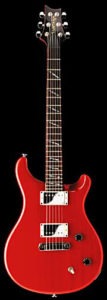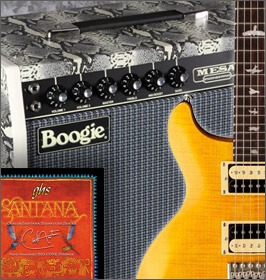With the popularity of the Santana I, Santana II, and Santana III guitars, Paul Reed Smith recognized the need for a more affordable model that would be within the financial reach of a much wider pool of players. Thus, in 2001, they introduced the Santana SE model. (Although PRS doesn’t explain the initials, the “SE” may stand for “Student Edition,” or “Standard Edition.”)
 Santana SE Model: A Hybrid
Santana SE Model: A Hybrid
At less than a quarter the price of the least expensive Santana Signature guitar, there was no way for the SE model to include every feature and level of craftsmanship of it’s predecessors. However, Paul Reed Smith did a masterful job of creating an instrument with much of the power of the Signature models, married with some classic PRS specs.
One of the distinctions is where the guitars are manufactured (Santana Signature models are U.S.A.-made). Originally, the PRS SE Model was built in Japan, but the source appears to have changed within the first year or two, to Korea. From the quality of the instruments, though, it’s obvious that Paul Reed Smith’s quality control was strict.
 Part PRS, Part Santana
Part PRS, Part Santana
 In many particulars, the Santana SE models have more in common with other PRS guitars (particular the McCarty models) than with the Signature Santana guitars. The body shape is asymmetrical, with greatly reduced carving. After the first year or two, a pickguard was introduced — something none of the Santana Signature models have.
In many particulars, the Santana SE models have more in common with other PRS guitars (particular the McCarty models) than with the Signature Santana guitars. The body shape is asymmetrical, with greatly reduced carving. After the first year or two, a pickguard was introduced — something none of the Santana Signature models have.
The neck is a 25″ scale length with 22 frets, although it does maintain the “Santana wide fat” shape, with a 10″ radius. And the fretboard is Rosewood, albeit of a more standard quality than the high grade woods on the I, II, and III models.
Lacking the flamed Maple top, the Mahogany body doesn’t have the eye-popping grain of it’s more expensive brethren. But the finishes are lush and beautiful, in true PRS fashion.
 Electronics and Hardware
Electronics and Hardware
Like all Santana Signatures (except the original model), the SE guitars have two humbucking pickups, a Tone knob, Volume knob, and 3-position selector switch. The pickups are covered, and, though not up to the level of the Signature Santana pickups, have a good, powerful tone.
Generally, the model was available with either a PRS tremolo, or a PRS stop-tail bridge. Even with the tremolo-equipped models, however, the tuners are non-locking — which results in tuning problems during heavy tremolo use.
 Sound and Feel
Sound and Feel
By all accounts, the Santana SE model plays far above its price point, with a solid feel, and warm, sustaining tone. It delivers a very Santana-like sonic quality, yet has the typically light PRS body.
If you’re looking for the exact guitar Carlos Santana plays, this isn’t it. However, it is an excellent working musician’s instrument, and is available at a price most can afford: roughly $300 – $400, used (PRS stopped making them in 2007)
 Variation on a Theme
Variation on a Theme
Although no official distinction is made by the Paul Reed Smith company, the second phase of the Santana SE guitar — which had many of the same features, with a few differences — is known to the rest of the world as the Santana SE II model.
 PRS Santana SE Colors
PRS Santana SE Colors
Original finishes available: Gray Black, Royal Blue, Teal, Vintage Cherry



